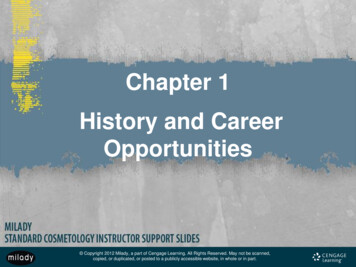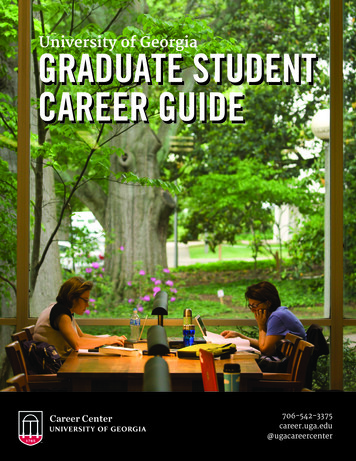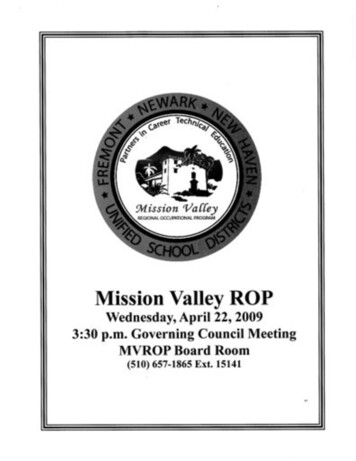
Transcription
Chapter 1History and CareerOpportunities Copyright 2012 Milady, a part of Cengage Learning. All Rights Reserved. May not be scanned,copied, or duplicated, or posted to a publicly accessible website, in whole or in part.
“The fact is that to do anything in theworld worth doing, we must not standback shivering and thinking of the coldand danger, but jump in and scramblethrough as well as we can.”– Robert Cushing Copyright 2012 Milady, a part of Cengage Learning. All Rights Reserved. May not be scanned,copied, or duplicated, or posted to a publicly accessible website, in whole or in part.
Objectives Describe the origins of personal beautification. Name the advancements made in cosmetology duringthe twentieth and early twenty-first centuries. List the career opportunities available to a licensedcosmetologist. Copyright 2012 Milady, a part of Cengage Learning. All Rights Reserved. May not be scanned,copied, or duplicated, or posted to a publicly accessible website, in whole or in part.
History Brief History – cosmetology encompasses a broad rangeof specialty areas Cosmetology – the art and science of beautifying andimproving the skin, nails, and hair Copyright 2012 Milady, a part of Cengage Learning. All Rights Reserved. May not be scanned,copied, or duplicated, or posted to a publicly accessible website, in whole or in part.
Cosmetology School HistoryEarly Twentieth CenturyEarly Twenty-First Century Copyright 2012 Milady, a part of Cengage Learning. All Rights Reserved. May not be scanned,copied, or duplicated, or posted to a publicly accessible website, in whole or in part.
Early History Cosmetology is one of the oldest professions in the world. Archaeological studies reveal the practice as early as theIce Age, over 10,000 years ago. Implements varied:– Sharpened flints and oyster shells– Bone, animal sinew, and strips of hide Copyright 2012 Milady, a part of Cengage Learning. All Rights Reserved. May not be scanned,copied, or duplicated, or posted to a publicly accessible website, in whole or in part.
Early History (continued) Pigments used to color hair, skin, and nails:– Roots and berries– Tree bark and leaves– Herbs and nuts– Minerals and insects Copyright 2012 Milady, a part of Cengage Learning. All Rights Reserved. May not be scanned,copied, or duplicated, or posted to a publicly accessible website, in whole or in part.
Egyptians Queen Nefertiti: 1400 BC– Stained nails red, wore lavish makeup Queen Cleopatra: 50 BC– Stained nails rust-red, erected personalcosmetics factory Copyright 2012 Milady, a part of Cengage Learning. All Rights Reserved. May not be scanned,copied, or duplicated, or posted to a publicly accessible website, in whole or in part.
Egyptians (continued) Copyright 2012 Milady, a part of Cengage Learning. All Rights Reserved. May not be scanned,copied, or duplicated, or posted to a publicly accessible website, in whole or in part.
Chinese Shang Dynasty: 1600 BC– Stained nails crimson or ebony Chow Dynasty: 1100 BC– Royal families wore gold and silver nails Copyright 2012 Milady, a part of Cengage Learning. All Rights Reserved. May not be scanned,copied, or duplicated, or posted to a publicly accessible website, in whole or in part.
Greeks Golden Age: 500 BC– Developed elaborate, artful hairstyles– Used perfumes and cosmetics in religious rites– Built elaborate baths– Women wore white lead on faces, kohl on eyes,and vermilion on cheeks and lips. Copyright 2012 Milady, a part of Cengage Learning. All Rights Reserved. May not be scanned,copied, or duplicated, or posted to a publicly accessible website, in whole or in part.
Romans Used lavish fragrances and cosmetics Used facials made of milk and bread or wine, corn,flour, or fresh butter Mixed chalk and white lead for cosmetics Hair color indicated class in society:– Noblewomen wore red.– Middle-class women wore blonde.– Poor women wore black. Copyright 2012 Milady, a part of Cengage Learning. All Rights Reserved. May not be scanned,copied, or duplicated, or posted to a publicly accessible website, in whole or in part.
Greeks and RomansGreeksRomans Copyright 2012 Milady, a part of Cengage Learning. All Rights Reserved. May not be scanned,copied, or duplicated, or posted to a publicly accessible website, in whole or in part.
European Trends of the Middle Ages AD 476 – 1450 Wore towering headdresses Wore intricate hairstyles Used cosmetics on skin and hair Colored lips and cheeks, but not eyes Copyright 2012 Milady, a part of Cengage Learning. All Rights Reserved. May not be scanned,copied, or duplicated, or posted to a publicly accessible website, in whole or in part.
Renaissance Transition from medieval to modern history Men and women wore elaborate, elegant clothing Fragrance and cosmetics used Lip, cheek, and eye coloring discouraged Hair dressed with ornaments or headdresses Copyright 2012 Milady, a part of Cengage Learning. All Rights Reserved. May not be scanned,copied, or duplicated, or posted to a publicly accessible website, in whole or in part.
Victorian Age 1837 – 1901 Austere and restrictive period Masks and packs made of honey, eggs, milk,oatmeal, fruits, veggies, and other natural ingredients Women pinched cheeks and bit lips for color Copyright 2012 Milady, a part of Cengage Learning. All Rights Reserved. May not be scanned,copied, or duplicated, or posted to a publicly accessible website, in whole or in part.
Twentieth-Century Trends 1906: Charles Nessler invented perm machine 1908: Max Factor launched cosmetics company 1910: Madam C. J. Walker factory and school 1920s: Advertising up to 25 million Copyright 2012 Milady, a part of Cengage Learning. All Rights Reserved. May not be scanned,copied, or duplicated, or posted to a publicly accessible website, in whole or in part.
Twentieth-Century Trends (continued) 1930s: First pre-heat perm method introduced;Charles Revson introduced nail lacquer colors 1940s: Cold wave replaced predecessors; aerosolcans invented 1950s – 2000: Tube mascara; paper nail wraps; colorweaving with foil; French manicure Copyright 2012 Milady, a part of Cengage Learning. All Rights Reserved. May not be scanned,copied, or duplicated, or posted to a publicly accessible website, in whole or in part.
Twenty-First Century Gentler, no-fade haircolor Estheticians rejuvenate skin, treat disorders Day and Men-only specialty spas Age of specialization Copyright 2012 Milady, a part of Cengage Learning. All Rights Reserved. May not be scanned,copied, or duplicated, or posted to a publicly accessible website, in whole or in part.
Twenty-First Century (continued)Beauty and fashion imagesthrough the decades. Copyright 2012 Milady, a part of Cengage Learning. All Rights Reserved. May not be scanned,copied, or duplicated, or posted to a publicly accessible website, in whole or in part.
Cosmetology Career PathsHaircolorspecialistsare ingreatdemand. Copyright 2012 Milady, a part of Cengage Learning. All Rights Reserved. May not be scanned,copied, or duplicated, or posted to a publicly accessible website, in whole or in part.
Cosmetology Career Paths (continued) Texture specialist Cutting specialist Salon trainer Distributor sales consultant Manufacturer's educator Cosmetology instructor Film, theatrical, or editorial stylist Copyright 2012 Milady, a part of Cengage Learning. All Rights Reserved. May not be scanned,copied, or duplicated, or posted to a publicly accessible website, in whole or in part.Cutting specialist
Cosmetology Career Paths (continued) Inventory managerDepartment headSalon educatorSpecial events managerAssistant managerGeneral managerSalon owner Copyright 2012 Milady, a part of Cengage Learning. All Rights Reserved. May not be scanned,copied, or duplicated, or posted to a publicly accessible website, in whole or in part.
Summary and Review What are the origins of personal beautification? Name the advancements made in cosmetology in thetwentieth and twenty-first centuries. List some career opportunities available to licensedcosmetologists. Copyright 2012 Milady, a part of Cengage Learning. All Rights Reserved. May not be scanned,copied, or duplicated, or posted to a publicly accessible website, in whole or in part.
Congratulations!You have completed one unit of studytoward course completion. Copyright 2012 Milady, a part of Cengage Learning. All Rights Reserved. May not be scanned,copied, or duplicated, or posted to a publicly accessible website, in whole or in part.
Used facials made of milk and bread or wine, corn, flour, or fresh butter Mixed chalk and white lead for cosmetics Hair color indicated class in society: . Masks and packs made of honey, eggs, milk, oatmeal, fruits, veggies, and other natural ingredients Women pinched cheeks and bit lips for color











